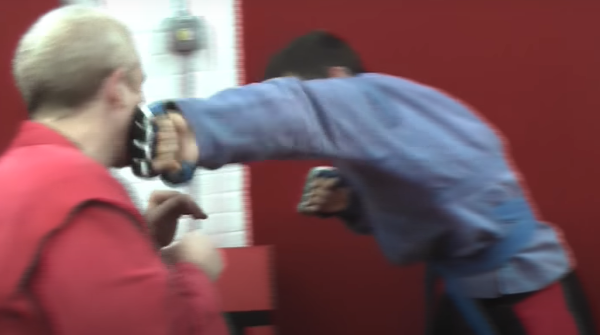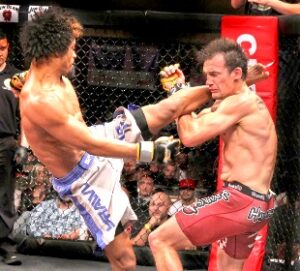
Are you wondering what a casting punch in MMA/martial arts is?
In this article, we’ll look at what a casting punch in MMA/sambo is, where the casting punch originates, how to throw a casting punch in MMA, the effectiveness of a casting punch in MMA, and more.
Contents
What Is a Casting Punch In MMA/Sambo?
A casting punch, or sambo casting punch, is an unorthodox long-range hooking punch thrown with a whipping motion. It’s thrown with the thumb facing down, the pinky finger facing upward, and the palm facing away from the opponent, and it aims to connect with the index and second knuckle.
The casting punch’s original purpose in sambo was as a strike disguised to initiate a grab or clinch, but casting punches are now also used as an effective long-range hooking strike in MMA and sambo.
These purposes were then combined so that a casting punch was used to grab an opponent’s sambovka (sambo gi) if it missed as a strike. As there’s no gi in MMA, fighters use a casting punch to grab around the back of an opponent’s head for a head and arm throw or trip, or to close the distance and clinch.
Unlike a conventional hook where the arm and forearm are at a 90-degree angle when hooking, the casting punch often connects with the arm fully straightened when intended as a strike. Using it at a closer distance is what allows the hand to wrap around an opponent’s head if the strike misses.
Also, a normal hook connects with the front of the knuckles, while the casting punch connects with the point and/or top part of the knuckles. This means the casting punch puts less stress on the metacarpal bones (the five bones on top of the hand which connect to the knuckles).
This is particularly useful in MMA as fighters wear 4 oz gloves, which offer less protection than more padded gloves used in muay Thai (10) or boxing (8,10), for example.
Where Does the Casting Punch Originate?
The exact origins of the casting punch are unknown, but it originates from bare-knuckle boxing in the 17th to 19th century under the 1743 Broughton Rules and later the 1838 London Prize Ring Rules.
When boxing gloves were mandated under the 1867 Queensberry rules, the casting punch became less effective and was used less because their hands were now protected on all shots, the rotation was harder, and they couldn’t connect with the point and/or top part of the knuckles.
The casting punch was then used in sambo from the 1920s onward and more recently in MMA since the mid-90s because of its versatility as a strike and as a technique to initiate a grapple – especially in sambo where a sambovka (gi) can be grabbed.
The casting punch takes its name from the casting of a fishing rod, as the whipping motion used in a casting punch is very similar to the whipping figure-of-8 motion when casting a fly fishing line.
How To Throw a Casting Punch In MMA/Sambo
Here’s how to throw a casting punch in MMA, step by step.
- Start by leading the shoulder forward
- Bring the elbow up to shoulder height
- Whip the arm around toward the opponent
- As the arm extends, turn over the fist so the pinky is up and the thumb is down (like you’re telling the time)
- Connect to the intended target with the first two knuckles
- Keep the chin tucked under the raised shoulder
- Follow up with strikes, initiate a grapple, use the punching arm to block or parry, or step backward out of range
Note: The casting punch is most effective as a counterpunch, thrown with the rear hand after stepping/slipping to the side due to the angle created for a long-range hooking strike around an opponent’s punch.
Practice until the casting punch can be performed in one swift motion. Here’s a short video showing how to throw a casting punch and also how Fedor Emelianenko mixed in some casting punches.
Is a Casting Punch Effective in MMA/Sambo?
A casting punch can be a very effective technique in MMA, but it also has its downsides.
A casting punch can be effective in MMA for the following reasons.
1. Long-range and powerful hook
Unlike a conventional hook where the arm and forearm are at a 90-degree angle when hooking, the casting punch connects with the arm fully straightened which means it has the same range as a straight and as much power as the conventional hook.
2. Used to Close the Distance
Because it’s a long-range hook, a casting punch can be effectively used to close the distance on an opponent. This is useful for dirty boxers or fighters who are shorter in height or have a shorter reach (often mesomorphs) and want to initiate a close-distance exchange.
3. Used to Initiate Grappling
Casting punches are effective at using a strike to initiate a grapple as the rotation of the hand is perfect for a grab hold. If the strike connects, then initiating a grapple is easy, but casting punches can be used to initiate a grapple even if they miss.
Casting punches most often miss when they’re thrown as a long-distance strike and the opponent steps in at the same time. Here, the arm can wrap around the back of an opponent’s head to initiate a throw (head and arm), trip, or dominant clinch position.
If timed well they can also be adjusted into dominant clinch positions such as a Thai clinch, or a single collar tie where the rear hand secures an underhook on the other side.
4. Defensively Sound
A casting punch is defensively sound as it finishes as a straight shot, which means the arm can be used to block or parry. Also, a casting punch first brings the shoulder forward, and when the hand turns down the shoulder comes up, which allows the user to tuck their chin under their shoulder when striking.
Combined, most countershots to a casting punch are defended with the straight arm frame, blocked by the shoulder, or made less impactful with a shoulder roll.
5. Counterpunching
A casting punch is great as a counterpunch as it’s long range and a lot of its power comes from the shoulder and whipping motion rather than a large weight transfer.
This means the user can maintain great movement and slip or step to the side of a punch and whip around the casting punch to connect as a strike or initiate a grapple; where a conventional hook wouldn’t reach and the user can’t move as well because it requires a large weight transfer.
6. Sneaky Technique
A casting punch is effective because it’s a sneaky technique many fighters aren’t expecting. It can be thrown in various ways, from different angles, and in different ranges, so it can be hard to know where a casting punch is targeting.
Most often it can be disguised as a conventional hook or overhand, and fighters underestimate the range it can find as they’re expecting a shorter range hook or a wide looping overhand – but are actually hit with a whipping casting punch.
Casting punches can also be easily disguised and turned into a step-in elbow. This is effective against opponents expecting the casting punch and stepping into close range.
On the other hand, fighters may argue a casting punch isn’t very effective in MMA for the following reasons.
1. Not Great for the Rotator Cuff or Hand
Although there aren’t enough fighting or scientific examples, many fighters who frequently use casting punches have had many hand injuries (specifically thumb injuries), and many have complained of the punch feeling not so great for the rotator cuff.
Also, with the nature of fighting, it’s only normal some punches don’t land perfectly and injuries can occur. With the rotation of the shoulder and the power it generates, there’s more chance of injury with a casting punch.
Two fighters who often used casting punches, Fedor Emelianenko and Igor Vovchanchyn, both had many hand injuries in their career. Some fighters use casting punches and don’t have many injuries, and some fighters who injure their hand believe the trade-off to be worth it because it’s an effective punch.
2. High Risk Grappling
The main throw a casting punch leads to is a head and arm throw, which is a risky technique if done incorrectly or not in a swift motion as the opponent can take the back. Because of this, a fighter may decide to only use a casting punch against weak wrestlers/grapplers.
3. Slower than a Palm-down Hook
While the casting punch is powerful and has great range, it’s a slower technique than a palm-down hook and therefore may be best used against fighters with less striking speed, especially with counters.
Which MMA Fighters Use the Casting Punch?
Here are the MMA fighters well-known for using the casting punch.
- Igor Vovchanchyn
- Fedor Emelianenko
- Junior Dos Santos
- Andrei Arlovski
All of these fighters have been UFC/MMA champions and long-time veterans of the sport, showing how the casting punch is an effective tool in the arsenal of an MMA fighter.
Is a Casting Punch Legal in Boxing?
A casting punch is legal in boxing, as there’s nothing in the regulations against them.
However, hitting an opponent with the back of the glove is illegal in boxing, and as a casting punch rotates the hand down and the back of the glove is hooking toward an opponent, it’s quite easy to connect with the backhand when using large boxing gloves.
This means boxers face warnings and possible point deductions if they use the casting punch, so for them, it’s just not worth it.
Also, large boxing gloves make it much harder to rotate the fist, and a casting punch is less effective in boxing because it’s harder to hit an opponent through large gloves and a high guard; as opposed to MMA where there are a lot more techniques to look out for and there are gaps through the smaller 4 oz gloves.
The Bottom Line
So, ‘what is a casting punch in MMA/sambo?’
A casting punch, or sambo casting punch, is an unorthodox long-range hooking punch thrown with a whipping motion. It’s thrown with the thumb facing down, the pinky finger facing upward, and the palm facing away from the opponent, and it connects with the index and second knuckle.
The casting punch is effective in MMA because it can be used as an unpredictable long-range hook, to initiate a grapple, to close the distance, and as a counterpunch. The casting punch is also defensively sound, but it can be risky to use against great grapplers as they can take the back.




